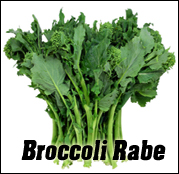Broccoli Rabe vs. Broccolini
Broccolini and Broccoli Rabe: two delicious greens, with deceptively similar origins due to their similar names and similar appearances. They look like broccoli, but do they taste like broccoli? Are they related? Were they made in a lab by mad broccoli scientists?
 We're going to tackle broccoli rabe first. Broccoli rabe, also known as Broccoletti, Broccoli di Rape, Cime di Rapa, Rappi, Rapini, and Friarielli, only looks similar to broccoli, but is actually part of the brassica rapa family (related to turnips and mustard greens). Broccoli rabe has a bitter, sometimes pungent, nutty flavor that can take some getting used to. Its leaves, stalks, and flowers are all edible. You'll want to thoroughly wash all the dirt and sand out of them, and remove any yellow leaves before cooking.
We're going to tackle broccoli rabe first. Broccoli rabe, also known as Broccoletti, Broccoli di Rape, Cime di Rapa, Rappi, Rapini, and Friarielli, only looks similar to broccoli, but is actually part of the brassica rapa family (related to turnips and mustard greens). Broccoli rabe has a bitter, sometimes pungent, nutty flavor that can take some getting used to. Its leaves, stalks, and flowers are all edible. You'll want to thoroughly wash all the dirt and sand out of them, and remove any yellow leaves before cooking.
First time eaters might not be ready for the strong flavor of broccoli rabe. Most people that I know that adore it do so because they are Italian and grew up eating it. You'll find it in a lot of Chinese dishes as well. It's commonly prepared by pan sautéing it in olive oil and seasonings which can then be served as a side dish. It's also great as a pizza topping or on hot sandwiches. The next time you have lunch next door at From the Boot, try their "Chicken Cutlet Italiano" sandwich with broccoli rabe for a delicious treat.
 Broccolini (a registered trademark of the Mann Packaging Company), also known as Baby Broccoli, Asparation, Asparations, Bimi, and Tender Stem, is in fact related to the broccoli we know and love. Broccolini is not young broccoli; it's a natural hybrid vegetable, a cross between broccoli and a Chinese kale (called kai-lan). Sweeter and more tender than broccoli, common cooking methods include sautéing, steaming, boiling, and stir frying. You can eat the entire bunch - leaves, stalk, and occasional yellow flowers. Easy to prepare and completely delicious, Broccolini is one of my all-time favorite side dishes. Broccolini (a registered trademark of the Mann Packaging Company), also known as Baby Broccoli, Asparation, Asparations, Bimi, and Tender Stem, is in fact related to the broccoli we know and love. Broccolini is not young broccoli; it's a natural hybrid vegetable, a cross between broccoli and a Chinese kale (called kai-lan). Sweeter and more tender than broccoli, common cooking methods include sautéing, steaming, boiling, and stir frying. You can eat the entire bunch - leaves, stalk, and occasional yellow flowers. Easy to prepare and completely delicious, Broccolini is one of my all-time favorite side dishes.
|
|
|


